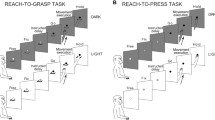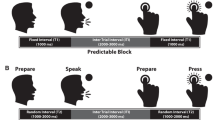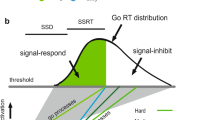Abstract
A voluntary motor act requires recognition of the informational content of an instruction. An instruction may contain spatial and temporal information. The recently proved role of the monkey frontal cortex in time computation, as well as in motor preparation and motor learning, suggested that we investigate the relationship between premotor neuron discharges and the temporal feature of the visual instructions. To this purpose, we manipulated the duration of an instructional cue in a visuomotor task while recording unit activity. We found two types of premotor neurons characterised by a discharge varying in relation to the duration of the cue: (1) “motor-linked” neurons, with a specific premotor activity constantly bounded to the motor act; (2) “short-term encoders” neurons, with a premotor activity depending on the cue duration. The cue duration was the critical factor in determining the behaviour of the short-term encoders cells: when the cue ranged from 0.5 s to 1 s, they presented a preparatory activity; when the cue was longer, up to 2 s, they lost their preparatory activity; when the cue was blinked the cells anticipated their discharge. The activity changed in few trials. These data confirm and highlight the role of frontal cortex in encoding specific cues with a temporal flexibility, which may be the expression of temporal learning and represent an extended aspect of cortical plasticity in time domain.





Similar content being viewed by others
References
Bengtsson SL, Ehrsson HH, Forssberg H, Ullén F (2004) Dissociating brain regions controlling the temporal and ordinal structure of learned movement sequences. Eur J Neurosci 19:2591–2599
Bon L, Lucchetti C (1997) Attentional-related neurons in the supplementary eye field of the macaque monkey. Exp Brain Res 113:180–185
Caminiti R, Johnson PB, Urbano A (1990) Making arm movements within different parts of space: dynamic aspects in the primate motor cortex. J Neurosci 10:2039–2058
Chen LL, Wise SP (1995) Neuronal activity in the supplementary eye field during acquisition of conditional oculomotor associations. J Neurophysiol 73:1101–1121
Cisek P, Kalaska JF (2002) Simultaneous encoding of multiple potential reach directions in dorsal premotor cortex. J Neurophysiol 87:1149–1154
Coe B, Tomihara K, Matsuzawa M, Hikosaka O (2002) Visual and anticipatory bias in three cortical eye fields of the monkey during an adaptive decision-making task. J Neurosci 22(12):5081–5090
Crammond DJ, Kalaska JF (2000) Prior information in motor and premotor cortex: activity during the delay period and effect on pre-movement activity. J Neurophysiol 84:986–1005
Deiber MP, Wise SP, Honda M, Catalan MJ, Grafman J, Hallett M (1997) Frontal and parietal networks for conditional motor learning: a positron emission tomography study. J Neurophysiol 78:977–991
Evarts EV, Shinoda Y, Wise SP (1984) Neurophysiological approaches to higher brain functions. Wiley, New York
Goldberg G (1985) Supplementary motor area structure and function: Review and hypotheses. Behav Brain Sci 8:567–617
Gruber O, Kleinschmidt A, Binkofski F, Steinmetz H, von Cramon DY (2000) Cerebral correlates of working memory for temporal information. Neuroreport 11:1689–1693
Halsband U, Ito N, Tanji J, Freund HJ (1993) The role of premotor cortex and the SMA in the temporal control of movement in man. Brain 116:243–246
Judge SJ, Richmond BJ, Chu FC (1980) Implantation of magnetic search coil for measurement of eye position: an improved method. Vision Res 20:535–553
Kurata K (1993) Premotor cortex of monkeys: set- and movement-related activity reflecting amplitude and direction of wrist movements. J Neurophysiol 69:187–200
Leon MI, Shadlen MN (2003) Representation of time by neurons in the posterior parietal cortex of the macaque. Neuron 38:317–327
Lucchetti C, Bon L (2001) Time-modulated neuronal activity in the premotor cortex of macaque monkeys. Exp Brain Res 141:254–260
Lucchetti C, Lui F, Bon L (1998) Neglect syndrome for aversive stimuli in a macaque monkey with dorsomedial frontal cortex lesion. Neuropsychologia 36:251–257
Maquet P, Lejeune H, Pouthas V, Bonnet M, Casini L, Macar F, Timsit-Berthier M, Vidal F, Ferrara A, Degueldre C, Quaglia L, Delfiore G, Luxen A, Woods R, Mazziotta JC, Comar D (1996) Brain activation induced by estimation of duration: a PET study. Neuroimage 3:119–126
Massart DL (1997) Medical and pharmaceutical applications of principle component analysis. Verh K Acad Geneeskd Belg 59:287–325
Matelli M, Luppino G, Rizzolatti G (1991) Architecture of superior and mesial area 6 and adjacent cingulate cortex in the macaque monkey. J Comp Neurol 311:445–462
Mitz AR, Goldchalk M, Wise SP (1991) Learning-dependent neuronal activity in the premotor cortex: activity during the acquisition of conditional motor associations. J Neuroscience 11:1855–1872
Mushiake H, Inase M, Tanji J (1991) Neuronal activity in the primate premotor, supplementary, and precentral motor cortex during visually guided and internally determined sequential movements. J Neurophysiol 66:705–718
Olson CR, Gettner SN, Ventura V, Carta R, Kass RE (2000) Neuronal activity in macaque supplementary eye field during planning of saccades in response to pattern and spatial cues. J Neurophysiol 84:1369–1384
Rao SM, Harrington DL, Haaland KY, Bobholz JA, Cox RW, Binder JR (1997) Distributed neural systems underlying the timing of movements. J Neurosci 17:5528–5535
Remmel RS (1984) An inexpensive eye movement monitor using the scleral coil technique. IEEE Trans Biomed Eng BME 31 4:388–390
Riehle A, Requin J (1989) Monkey primary motor and premotor cortex: single-cell activity related to prior information about direction and extent of an intended movement. J Neurophysiol 61:534–549
Rizzolatti G, Matelli M, Pavesi G (1983) Deficits in attention and movement following the removal of postarcuate (area 6) and prearcuate (area 8) cortex in macaque monkeys. Brain 106:655–673
Rizzolatti G, Luppino G, Matelli M (1998) The organization of the cortical motor system: new concepts. Electroencephalography and Clinical Neurophysiology 106:283–296
Roux S, Coulmance M, Riehle A (2003) Context-related representation of timing processes in monkey motor cortex. Eur J Neurosci 18:1011–1016
Sasaki K, Gemba H (1982) Development and change of cortical field potentials during learning processes of visually initiated hand movements in the monkey. Exp Brain Res 48:429–437
Schall JD (1991) Neuronal activity related to visually guided saccadic eye movements in the supplementary motor area of rhesus monkeys. J Neurophysiol 66:530–558
Schlag J, Schlag-Rey M (1987) Evidence for a supplementary eye field. J Neurophysiol 57:179–200
Tanji J, Taniguchi K, Saga T (1980) Supplementary motor area: neuronal response to motor instructions. J Neurophysiol 43:60–68
Tehovnik EJ, Sommer MA, Chou IH, Slocum WM, Schiller PH (2000) Eye fields in the frontal lobes of primates. Brain Res Reviews 32:413–448
Vidal F, Bonnet M, Macar F (1995) Programming the duration of a motor sequence: role of the primary and supplementary motor areas in man. Exp Brain Res 106:339–350
Walter WG, Cooper R, Aldridge VJ, Mccallum WC, Winter AL (1964) Contingent negative variation: an electric sign of sensorymotor association and expectancy in the human brain. Nature 203:380–384
Weinrich M, Wise SP (1982) The premotor cortex of the monkey. J Neuroscience 2:1329–1345
Wise SP, Moody SL, Blomstrom KJ, Mitz AR (1998) Changes in motor cortical activity during visuomotor adaptation. Exp Brain Res 121:285–299
Acknowledgements
We thank Dr. G. Franchi for the helpful discussion of the preliminary data; Mr. E. Paiser and Dr. G. Pedrazzo for the software development; Dr. V. Lolli and Mr. V. Molino for animal care. Grants were provided by Università di Modena e Reggio Emilia; Ministero dell’Università e della Ricerca Scientifica e Tecnologica (COFIN).
Author information
Authors and Affiliations
Corresponding author
Rights and permissions
About this article
Cite this article
Lucchetti, C., Ulrici, A. & Bon, L. Dorsal premotor areas of nonhuman primate: functional flexibility in time domain. Eur J Appl Physiol 95, 121–130 (2005). https://doi.org/10.1007/s00421-005-1360-1
Accepted:
Published:
Issue Date:
DOI: https://doi.org/10.1007/s00421-005-1360-1




